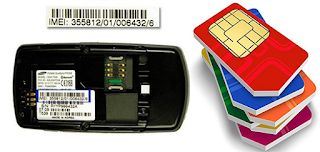A user carries a Mobile Station (MS), which can communicate over the air with a base station, called Base Tranceiver Station (BTS) in GSM. The BTS contains transmitter and receiver equipment. In order to keep the base stations small, the essential control and protocol intelligence resides in the Base Station Controller (BSC). Typically, several BTSs are controlled by one BSC and the combined traffic of the users is routed through a switch, called the Mobile Switching Center (MSC).
So GSM wireless communication system can brief System architecture as below:
- Mobile Station (MS)
- Base Station Subsystem(BSS)
- Network switching subsystem (NSS)
- Operation Support System (OSS)
 |
| GSM Architecture |
Mobile station (MS)
The MS consists of the mobile equipment (ME)and a smart card called the subscriber identity module (SIM). The SIM offers personal mobility since the user can remove the SIM card from one mobile device and place it in another device without informing the network operator. In contrast, most other 2G systems require a registration update to the operator.
 |
| Mobile Station (Mobile Equipment and SIM) |
- The (ME) mobile equipment is also uniquely identifiable by the international mobile equipment identity (IMEI). The IMEI and IMSI are independent, thus providing the user flexibility by separating the concept of subscriber from access device. Many operators still issue ‘locked’ mobile devices where the equipment is tied for use only on a particular operator’s network. A mobile device not equipped with a SIM must also still be able to make emergency calls. To protect the call from undesirable snooping or listening in, the IMSI will not always be transmitted over the cell to identify the subscriber. Instead a temporary IMSI (T-IMSI) identifier is used and changed at regular intervals. Note that for extra security the whole data stream is encrypted over the air interface.
- The SIM contains a globally unique identifier, the international mobile subscriber identity (IMSI), as well as a secret key used for authentication and other security procedures. The IMSI (or a variation of it for security purposes) is used throughout the network as the identifier for the subscriber. This system enables a subscriber to change the mobile equipment and still be able to make calls, receive calls and receive other subscriber information by simply transferring the SIM card to the new device. Any calls made will appear on a single user bill irrespective of changes in the mobile device.
- Interface between MS to BTS was called Um or Air Interface.
Here are Content for GSM Mobile Communication System


A great treatise is usually quiet since usable as the pain finished on there. Your current rules on how in order to bunch depressing a specific being used to learn pertinent info totally makes an attempt. This kind of explicits tug slab a lot much easier. Wireless Paging System
ReplyDeletePost a Comment